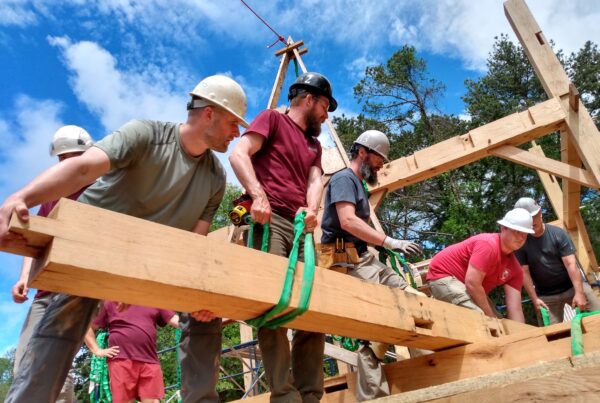Fr. Mark and I had the privilege of speaking at the Ciceronian Society Conference earlier this month in Harrisonburg, VA. Fr. Mark gave a rousing call to a re-embodied way of living, attuned to creation with our senses, present in our bodies as well as our souls to the reality of God’s created order.
My presentation was on the need to give our young men a meaningful place in our communities at an earlier age, and how apprenticeships offer a meaningful way to do so. Here is a version of the talk I delivered.
NB: We’ve had an apprentice working with us for the last few weeks, learning to timber frame specifically and about commercial building projects more generally. Thanks to Joseph for adding his strength and talent to the build. His time with us has been an exciting glimpse of what’s to come here at St. Dunstan’s Academy.
A Place for Young Men: Resurrecting Apprenticeship
Delivered at the Ciceronian Society Annual Conference
March 14, 2025
No Place for Young Men
If you were to scan the titles from the social science best-hits list from, say, the last ten years, you might conceivably and understandably determine that our young people generally, and our young men specifically, were living on the edge of some sort of precipice.
Here are four you may have run across:
- Boys Adrift: the five factors driving the growing epidemic of unmotivated boys and underachieving young men
- Alone Together: Why we expect more from technology and less from each Other
- The Anxious Generation: How the Great rewiring of Childhood is causing an Epidemic of Mental Illness
- Of Boys and Men: why the modern male is struggling, why it matters, and what to do about it
The list is much longer, but these titles give a good sense of the common evaluation about how young men, generally, have fared in the first quarter of the 21st century.
Apparently something is wrong in the years of adolescence, when talents and capacities and desires ought to be coming alive. But these young men’s problems do not end when they reach the age of majority. They don’t seem to graduate from the malaise and worry pointed out by so many of these books. Our average age of marriage continues to push later, and the family, that cornerstone of the rest of society, is avoided or postponed into the 30s. Our adolescents seem stuck in an uncertain holding pattern, delaying adult responsibilities indefinitely.
For now, I’m not going to sift through which claims are accurate, which inflated, or which methods of social-scientific inquiry are correct. For the sake of argument, I’m going to take it for granted that where there is smoke, usually there is fire, and of late there has been a relatively dark cloud billowing forth from the press in regard to the health and sanity of the upcoming generation.
The health of our young people and the health of our society are intertwined, making these trends of interest to all of us who care about forming and maintaining strong communities. G.K. Chesterton captured this truth when he quipped that “Education is simply the soul of a society as it passes from one generation to another.” Human life is finite, so our traditions, our places, and our culture must be carefully handed on if they are to live beyond our mortal timeframe. Education, not to be confused with schooling, is how a community maintains and perpetuates its values and traditions from one generation to the next.
I’d like to suggest that the apparent crisis our teens are experiencing, and that threatens the continuation of our shared culture, is caused by a deeper tectonic disturbance than the omni-presence of smartphones, which is, admittedly, linked to most of the other problems—or “the Great Dechurching of America”, or schools designed for social programming rather than the joyous exercise of the human intellect.
We have, as a society, for over 100 years, removed adolescents as essential parts of our economic and communal life, and sequestered them into an isolated silo, a system that reinforces an inert individualism, and inhibits young people from discerning meaning in their lives.
Meaning is discovered in the context of a particular community, a place. From the very beginning, western tradition has emphasized this point, and continued to do so until the recent past.
Aristotle, for example, famously distinguished humans from the rest of the animal kingdom, calling us the “Zoon Politikon,” the community animal, in loose translation. A millennia before Aristotle’s formulation, Moses records YHWH’s first time proclaiming something to be not good: “it is not good for man to be alone” (Genesis 2). We need, ontologically, to be connected in strong bonds to our fellow man, and this is true of our adolescents as well.
But this connection does not happen spiritually apart from material realities. Our community life has to start out as something embodied. Out togetherness, our shared life in a community, flows from common work for a common good.
Alienate man from his work, and you do alienate him from the means of production, but you also and more significantly alienate him from his fellow man. And this is what we’ve done to our teenagers. Their labor, their talents, their growing strength, creativity, drive, and intelligence, isn’t placed in the service of the community. It is focused roughly 100% on building individual resumes, presumably to go off, somewhere else, down the road, to earn credentials, and then a paycheck. This is deeply problematic for our teenagers in their understanding of themselves and their place in society.
Here is my main contention: We have no essential and meaningful place for the young men in our society. We don’t know what to do with their zeal, their testosterone, their noise, their moods—so we let them either purge them on the athletic field, or withdraw into the virtual realm.
Of course, it has not always been this way. I’d like to give two glimpses of an alternative way of relating to our young men, and relating our young men to their communities. This alternative way might give these young men a place again, and start to undo the solipsistic spell that fell on them beginning not so long ago.
Working to Find a Place
The first glimpse comes from George MacDonald’s fairy tale, The Princess and the Goblin. Apologies in advance for spoiling the plot– Fortunately the wonder of this book isn’t ruined by synopsis.
The story tells of a young princess who lives in a carefully guarded estate, watched constantly by servants and sentinels, because a horde of hateful cave-dwelling creates lurks beneath the realm, and is plotting to kidnap the young lady.
The other main character is Curdie, a miner (M I N E R), who is, we’re told, twelve years old.
As a twelve year old, Curdie is already participating in his father’s work—not unlike another twelve year old you’ve read about in St. Luke’s gospel.
Curdie spends his days in the mine, tracking and surveilling the goblins, and is able to narrowly prevent disaster by fearlessly, doggedly skirting the world of terror and danger in the mines. He tracks goblins, harasses them, is at one point captured by them, and even learns how to overcome them in battle. He is twelve years old, and yet saves his community.
This story is strange when juxtaposed to what Contemporary Man is writing about adolescents, isn’t it? I see at least three reasons why.
First, a certain type of modern social scientist would read of Curdie’s actions, and observe that the adolescent toys with danger, risks life and limb, and does several rash things, because he is, after all, a young man, and his pre-frontal cortex is underdeveloped. I think a more accurate and sane observation is that George MacDonald had some knowledge of healthy adolescent boys, and knows that God gives them the unique gift of recognizing danger and carrying on anyway—to trim the sails in a storm, to push forward in the teeth of battle, to do risky things for the sake of the community, their families, and often for a young lady they are trying to win. Adolescent boys have this unique power. But this is not the story we tend to hear about young men today.
The second feature of this story that seems unfit for our times, is the fact that what ties Curdie to reality is his manual labor, his work. The courtiers live aboveground in a manicured palace, carrying out court life and trying unsuccessfully to pretend all is well.
Underground, Curdie is dirty, and tired, and under threat to his life, but his labor in the mine allows him to keep his finger on the pulse of the kingdom. His labor is his link to reality. Not so for contemporary youth, or the stories we hear of them.
Finally, as so excellently exhibited by Curdie’s character, not only is risk, is danger, not a deterrent for most teenage boys. Risk and danger are interestingly, and not perversely, either, attractive to teenage boys, especially when the risks are taken on behalf of others, for a noble cause.
Real risk is, I think, a key to engaging our young men. If you want a young man to leave the doldrums and come alive, give his something real to do—something in which he could fail, but in which, if he succeeds, his labor is a real boon to his fellows.
But this is, after all, a fairy tale. Fortunately, the same truth about young men and risk turns up time and again in the course of history.
What Young Men Once Did
One such historical instance, and my second glimpse of an alternative way of relating young men to their communities, comes from Booker T. Washington’s Up From Slavery.
Washington found a way to invite young men into a meaningful adventure, one both needed by the community and important for the young men themselves. When building the Tuskegee Institute, he decided to make use of the strength and capacities of the young men in Tuskegee to construct the school. Here is a brief anecdote from the work:
| From the very beginning, at Tuskegee, I was determined to have the students do not only the agricultural and domestic work, but to have them erect their own buildings. My plan was to have them, while performing this service, taught the latest and best methods of labour, so that the school would not only get the benefit of their efforts, but the students themselves would be taught to see not only utility in labour, but beauty and dignity; would be taught, in fact, how to lift labour up from mere drudgery and toil, and would learn to love work for its own sake. [. . .] I told those who doubted the wisdom of the plan that I knew that our first buildings would not be so comfortable or so complete in their finish as buildings erected by the experienced hands of outside workmen, but that in the teaching of civilization, self-help, and self-reliance, the erection of buildings by the students themselves would more than compensate for any lack of comfort or fine finish. [. . .] During the now nineteen years’ existence of the Tuskegee school, the plan of having the buildings erected by student labour has been adhered to. In this time forty buildings, counting small and large, have been built, and all except four are almost wholly the product of student labour. As an additional result, hundreds of men are now scattered throughout the South who received their knowledge of mechanics while being taught how to erect these buildings. Skill and knowledge are now handed down from one set of students to another in this way, until at the present time a building of any description or size can be constructed wholly by our instructors and students, from the drawing of the plans to the putting in of the electric fixtures, without going off the grounds for a single workman. |
That is an amazing story. It is important to note that these young men were not on their own– they tackled the work at hand in the presence of other adult mentors, both their teachers, and the older students who joined them in the program.
Washington’s voice comes to us from a foreign time, and the obstacles he faced to build his institution are radically different from those we might face today. We may not be living through the pains of reconstruction in the Deep South, but Booker T. did not have to deal with OSHA, or wade through the expensive, onerous reporting process required by NEPA and its subsequent regulations, which create a morass of compliance paperwork so expensive, only a corporation can hope to build anything of more than modest scale in a reasonable amount of time. Booker T. had never heard of Uniform Statewide Building Codes, or contractor’s licenses, or properly graded and stamped number two or better lumber. Instead, when the teachers and students wanted bricks, they made them. When they wanted a building, they built it.
But it is worth saying that Washington was missing assets we have easy access to. We live in an affluent society. And there is a growing awareness that the American Dream as commonly understood might be somewhat shallow. It is an ideal time to invite young men into roles of responsibility in our communities. Many of them are open to it, and many are willing to answer the call. All that remains is the communities willing to call them.
What Young Men Might do Again
What must these communities do, practically, in order to initiate a meaningful shift in culture for our young men? First, we need to provide them with rites of passage that clearly delineate their roles and responsibilities as young adults from those of children. These rites should involve risk and strength, and intelligence, and afterwards a communal, public recognition that the young man’s social status has permanently changed.
Second, once the young man has been initiated into real adult society, we need to consciously and intentionally create opportunities for young men to become productive, integrated members of the local economy. Easier said than done—what local economy? So much of our common life has been offloaded to either corporations or machines, there is little we now feel equipped to do for ourselves.
So we must first attempt to have a local economy, one founded on productive labor, and as we build it, we must do so including a place for our young men. If we find in our searching that we have accepted a form of society which doesn’t have room for young men, then we must collectively repent, and opt for a manner of living that finds and makes meaningful roles for them to occupy with their budding strength and gifts. The most logical place for them is as apprentices to those who work in the embodied arts, wherever those arts are alive and well.
An apprentice brings his unique resources—namely, his enthusiasm, energy, low cost of living, and time—to bear on his master’s work, and participates meaningfully in that work. The apprentice shares in the master’s toil, and the master reciprocates by gifting the apprentice with a tie to the knowledge and traditions of the trade. By working on the periphery, on the edges, of the master’s craft, the apprentice gradually becomes capable of moving closer to the heart of the labor. And in doing so, he realizes he is an essential part of a community much larger than himself—he finds his connection to the community through the medium and conduit of his manual work. Apprenticeship is, then, one answer to the problem of alienated and marginalized young men.
So our contractors, our farmers, our electricians and plumbers, our foresters, surveyors, excavators and linemen, ought to be thinking about how they are recruiting and apprenticing the next generation. Any trade that allows participation before earning a college degree should be thinking this way. Granted, most of us are not active in the embodied arts, but that does not make this solution irrelevant to us. Even if we are not active in one of the manual trades, we need to take responsibility for the narrative our young people hear. As long as embodied work is second-class, as long as a college degree and white-collar work is tacitly viewed as the only dignified path to the Good Life, our young men will never seriously consider whether God has called them to work in more earthy realms.
It is a fitting time to restore apprenticeship as a viable choice for the next generation. It is up to us to figure out how to do so.





